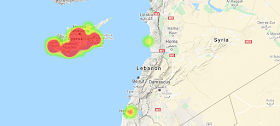The Cyprus Astronomy Organisation has reported a bright fireball meteor seen off the southeast coast of the island slightly after 10.00 pm local time (slightly after 8.00 pm GMT) on Wednesday 21 January 2020. The meteor was seen from across the island, as well as from coastal areas of Lebanon and Israel, with the Israeli Astronomical Association describing the object as having a bright blue colour, which may be indicative of an object with a high magnesium content. A
fireball
is defined
as a meteor
(shooting star) brighter than the
planet Venus. These are typically caused by pieces of rock burning up in
the atmosphere, but can be the result of man-made space-junk burning up
on re-entry.
The 21 January 2020 meteor seen from the southern coast of Cyprus. Jennifer Vanessa Brown/Kition Planetarium and Observatory.
Objects
of this size probably enter the Earth's atmosphere several times a
year, though unless they do so over populated areas they are unlikely to
be noticed. They are officially described as fireballs if they produce a
light brighter than the planet Venus. The brightness of a meteor is caused by friction with
the Earth's atmosphere, which is typically far greater than that caused
by simple falling, due to the initial trajectory of the object. Such
objects typically eventually explode in an airburst called by the
friction, causing them to vanish as an luminous object. However this is
not the end of the story as such explosions result in the production of a
number of smaller objects, which fall to the ground under the influence
of gravity (which does not cause the luminescence associated with
friction-induced heating).
Heat map
showing areas where sightings of the meteor were reported (warmer colours indicate more sightings). American Meteor Society.
These 'dark objects' do not continue along the path
of the original bolide, but neither do they fall directly to the ground,
but rather follow a course determined by the atmospheric currents
(winds) through which the objects pass. Scientists are able to calculate potential trajectories for hypothetical dark
objects derived from meteors using data from weather monitoring services.
Heat map of Cyprus
showing areas where sightings of the meteor were reported, and the
apparent path of the object (blue arrow). American Meteor Society.
See also...
Follow Sciency Thoughts on Facebook.









